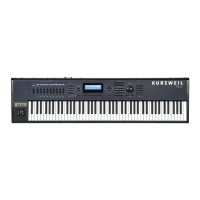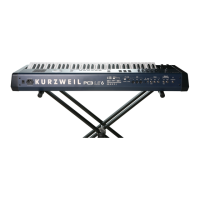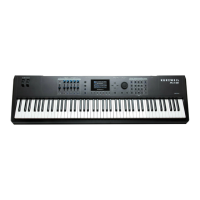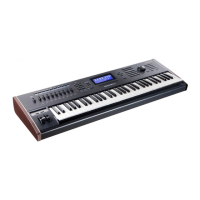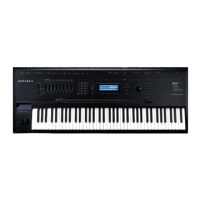Effects
Pitcher
9-23
50% Weight is the relative amount of attenuation added when the LFO is at the -6dB point. This
causes the LFO shape to bow up (positive values) or down (negative values). Range is -16 to
3 dB.
L/R Phase sets the phase relationship of the channels. “In” flips the left channel’s LFO out of
phase, with the result that the effect turns into an auto-balancer. “Out” leaves the left LFO alone.
Pitcher
Pitcher applies a filter to the input signal which has a series of peaks in the frequency response.
These peaks are normally adjusted so that their frequencies are all multiples of a specific,
selectable frequency, which imposes a strong sense of pitch at the selected fundamental
frequency.
Pitch. The fundamental pitch imposed upon the input, in MIDI note numbers from C-1 to G9.
Ptch Offst is an offset from the pitch frequency in semitones, from -12.0 to 12.0. It can be useful
to assign pitch bend, a ribbon, or another continuous controller to this parameter through a
MOD.
Odd Wts, Pair Wts, Quartr Wts, Half Wts are parameters that control the shape of the frequency
response of Pitcher. An exact description of what each one does is, unfortunately, impossible,
since there is a great deal of interaction between them. For more information and examples, see
the KSP8 Algorithm Reference Guide.
Ring Modulation
Ring modulation multiplies two signals (the “carrier” and the “modulator”) together to produce
unusual, often non-harmonic, overtones. The Ring Modulator algorithm in the PC3 has two
modes: “L*R” in which two mono signals are modulated together; and “Osc”, in which the
input is stereo, and it is modulated with the sum of five waveforms that are generated from
oscillators within the algorithm itself. Four of these oscillators are sine waves, while one
(Oscillator 1) offers a selection of waveforms.
Wet/Dry. When the algorithm is in “L*R” mode, this controls how much of the left signal only is
passed dry (the right signal isn’t passed dry at all).
Mod Mode selects between the two modes.
Osc1 Lvl is the level of Oscillator 1, from 0 to 100%.
Osc1 Freq is the frequency of Oscillator 1, from 16 to 25088 Hz.
Osc1 Shape is the waveshape of Oscillator 1, selectable from Sine, Saw+, Saw-, Pulse, and Tri.
Osc1PlsWid (Pulse Width). When Osc1 Shape is set to Pulse, this sets the pulse width as a
percentage of the waveform period. When the width is set to 50%, the result is a square wave.
This parameter has no effect if other waveform types are chosen. Range is 0 to 100%.
Osc1Smooth smooths (removes the higher harmonics from) the Saw+, Saw-, and Pulse
waveforms. A Sawtooth wave becomes more like a triangle wave, and a Pulse wave becomes
more like a sine wave. Range is 0 to 100%.
The other four oscillators, Sine2 through Sine5, each have Lvl and Freq controls.

